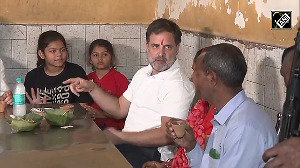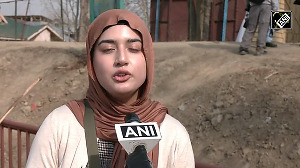Everybody loves a parade and the sight of smartly turned out military units marching with precision behind their respective bands, playing various marches makes everyone puff their chest in pride. However bad the previous year and however depressing the economic scene, the Republic Day parade lifts the spirits and restores the feel good factor for the rest of the year -- well, at least until the Budget a month down the line.
Parades have been around for thousands of years. The Roman legions were accorded the honour of marching through the capital before the Senate and their citizens after every victory, the victorious general leading the phalanx of warriors.
Hitler would use massive organised rallies to great advantage to strengthen his hold over people and to impress them with the invincibility of the Nazi party. Hundreds of thousands of people would attend these rallies, which have been described like attending mass religious ceremonies.
With night-time rallies and torch light parades, the Nazis were able to create a magical atmosphere that would engulf the participants.
In India the RSS tried to duplicate the Hitler magic with rallies a la Nuremberg. Alas, the sight of knicker-clad lathi wielding participants attracts more derisive laughter than awe.
In the West, military parades are normally the done thing after victory in battle or war. There was a military parade through the streets of Mumbai after the Allied victory in Africa and, of course, massive victory parades in the West after the victory in Europe called VE day and then the victory over Japan, called the VJ day.
In recent times the overwhelming image of a massive parade, which lingers in the mind is of the annual May Day parade in Moscow's Red Square. The spectacle of goose-stepping troops, the massive show of flags and the long inter-continental missiles on trailers was designed to impress the West with the Soviet Union's military might and progress. Not many had realised at that time that behind the pomp and spectacle lay a country in economic doldrums due to its massive military spending.
In India, fortunately we have tempered the show of military force with a dash of gentler spectacle and the addition of civilian participation. The inclusion of school children, folk dancers from all parts of India and the imaginative floats from a number of states adds just the right touch of colour and culture to what would otherwise have turned out to be a show of military arrogance.
The Republic Day parade is also an occasion for some military equipment to make its first public appearance. Thus, most of India's newly acquired aircraft, new tanks and new ships (not the ships but the models) made their first public appearances at the RD parade. The Indian developed Arjun tank first rolled down Raj Path during the parade and so did the Prithvi and Agni missiles. Indeed one also saw Pakistan display their HATF and later the Ghauri and Shaheen missiles at the Pakistan Day parades.
The Republic Day parade is also a venue for some diplomatic games. The chief guest is carefully chosen. This year, the choice of President Mohammed Khatami of Iran, a country which is one of the three in Bush's 'Axis of Evil' (the other two are Iraq and North Korea), not only helped India gently remind the US that we do not necessarily agree with them on our enemies and friends but is also one of the steps in forging a strategic oil/gas alliance with an old friend from the Gulf.
The event is possibly the only event in the country to start and finish precisely on time, where even VIPs, if they do not arrive on time are likely not to find a place. A tradition established over 50 years ago, the Republic Day parade is now an institution. One of the few events which shows what India is all about, a mixture of race, creed, culture and diversity. The good it does is worth far more than the amount spent on it. It must remain to remind us each year what we as a people are capable of achieving.






 © 2025
© 2025